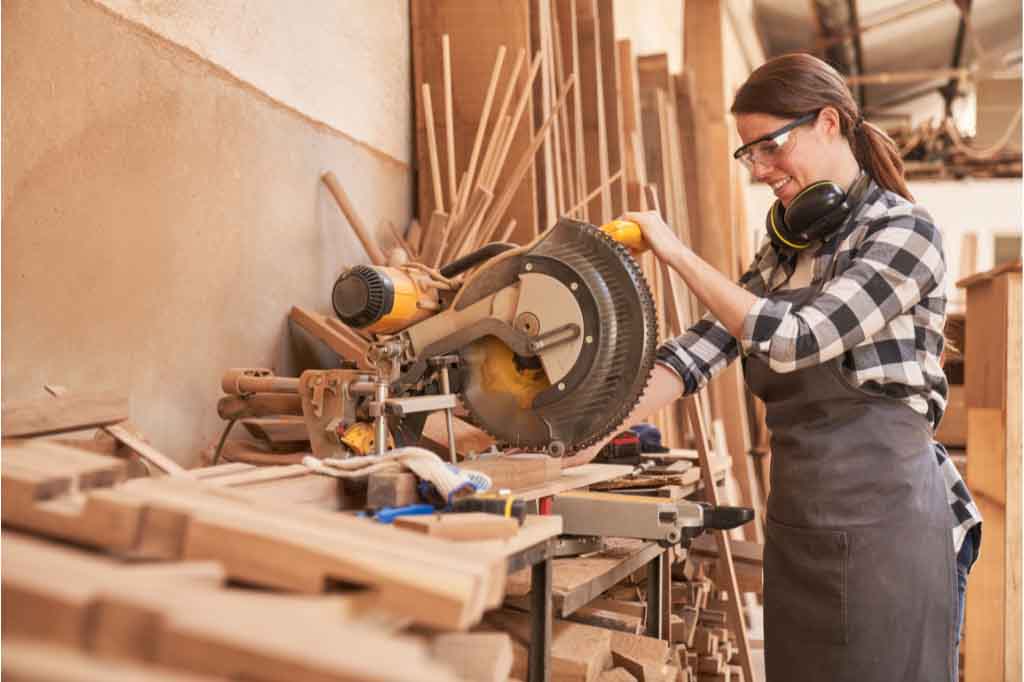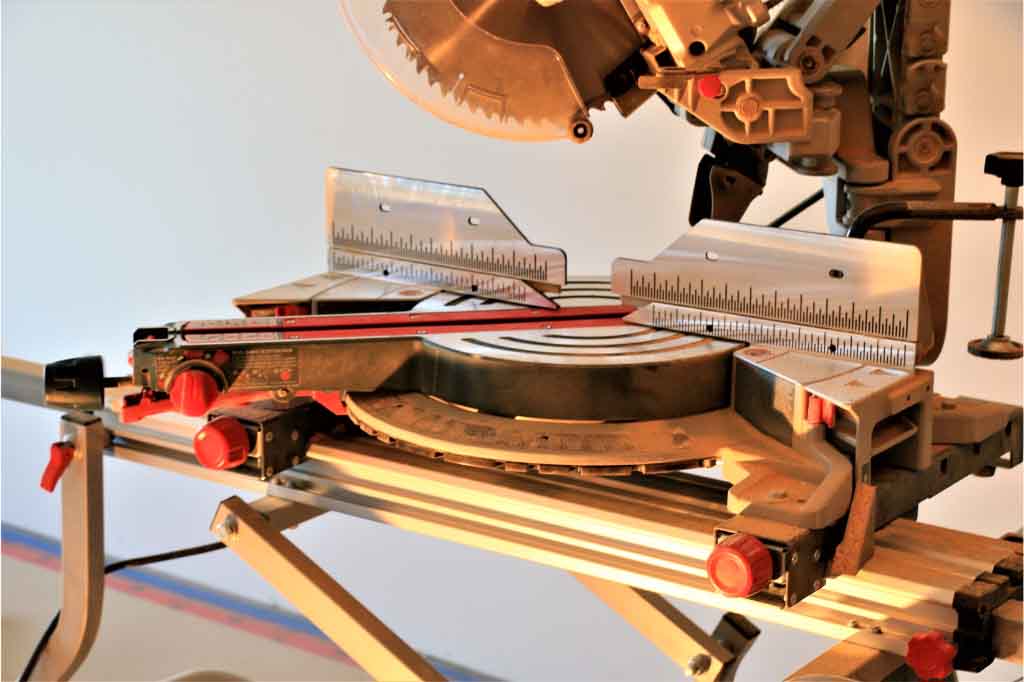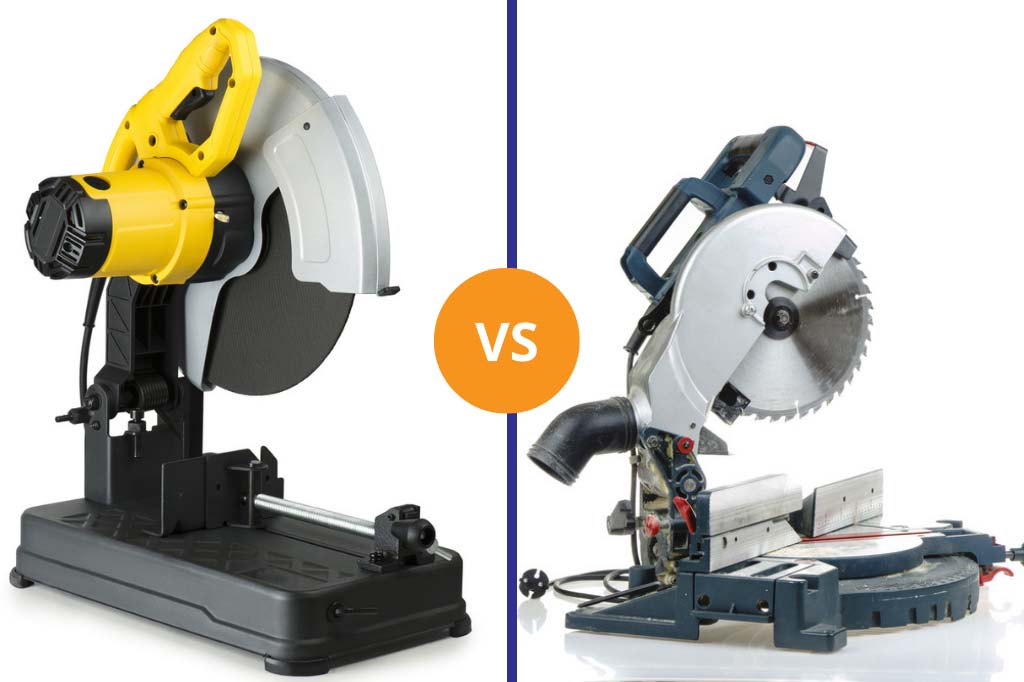If you’re in the market for a new saw, you may be wondering whether a chop saw or mitre saw is the right choice for you. Both types of saws have their own unique benefits, so it’s important to know what each one has to offer before making a purchase.
The colloquialism used in the construction and woodworking industry often mixes up chop saws and mitre saws. While both types of chop saws are portable cutting tools, they serve different purposes.
In this chop saw vs mitre saw comparison article, Tools Detail will break down the key differences between these two types of saws so you can make an informed decision about which one is right for your needs.
What Is a Chop Saw?
A chop saw is a portable cutting tool that is often used in the construction and woodworking industries. It is similar to a mitre saw but has a different purpose. A chop saw is used to cut long pieces of lumber or metal into smaller pieces.

The chop saw is typically powered by an electric motor, and it has a circular blade that is mounted on an arm. The blade can be rotated to any angle, and this allows the chop saw to be used to cut material at any angle.
The chop saw is a very versatile tool that can be used to make quick, accurate cuts. It is also very portable, so it can be easily transported from job site to job site.
The abrasive disc chop saw is a type of chop saw that uses an abrasive disc instead of a blade. These saws are often used to cut metal, and they can make very precise cuts. The disc is made of grit and can quickly chop through metal.
Best Chop Saw
While a chop saw can cut through virtually anything, its speed may not be suitable for everyone. A chop saw can cut through wood, metal, plastic, and even stone, but it is not as fast as a mitre saw or circular saw.
As you make more cuts with a chop saw, the blade will eventually become dull, whereas its diameter will slowly get smaller. This will have an impact on the accuracy of your cuts, so it is important to keep the blade sharp.
Some sites may require a hot works permit to use a chop saw since it can create sparks. If you are going to use a chop saw in an area where there is a risk of fire, be sure to check with your local authorities first.
What Is a Mitre Saw?
A mitre saw is a powerful tool that is used to make precise, angled cuts in wood or metal. It is similar to a chop saw but is designed for making more accurate cuts.

This type of saw consists of a circular saw blade that is mounted on an arm. The blade can be rotated to any angle, which allows the mitre saw to make angled cuts.
Mitre saws are often used in home improvement and carpentry projects. They can be used to make simple crosscuts or more complex angled cuts. In order to make a mitre cut, the saw is set at the desired angle, and the workpiece is placed against the fence. The saw is then activated, and the blade swings down onto the workpiece, cutting it.
Mitre saws come in both standard and sliding varieties. A standard mitre saw has a fixed arm, while a sliding mitre saw has an arm that slides out from the body of the saw. This allows for longer cuts. Sliding mitre saws are typically more expensive than standard mitre saws.
There are also single and double bevel mitre saws. A single bevel mitre saw can only cut at one angle, while a double bevel mitre saw can cut at two angles. This allows for more versatility when making cuts.
Mitre saws are available in a variety of sizes, from small handheld models to large stationary models. The size of the saw you need will depend on the projects you plan to use it for.
Chop Saw vs Mitre Saw — How Do They Differ?
Now that we have a better understanding of what chop saws and mitre saws are, let’s take a look at the chop saw vs mitre saw and how they differ.
1. Type of Cut
One of the biggest differences between chop saw vs mitre saw is the type of cut they are designed to make.
As we mentioned earlier, chop saws are typically used to make long cuts in lumber or metal. They can also be used to make crosscuts, but their primary purpose is to make long cuts.
Mitre saws, on the other hand, are designed to make precision cuts. They are often used to make mitre cuts, which are cuts that are made at an angle. Mitre saws can also be used to make crosscuts, but their primary purpose is to make accurate, precise cuts.
2. Size and Portability
Another big difference between chop saws and mitre saws is their size. Chop saws are typically much larger than mitre saws. They are also not as portable, which can be a big consideration if you plan to use your saw on the job site.
Mitre saws, on the other hand, are smaller and more portable. This makes them a good choice for projects that require more precision than a chop saw can provide.
Size and portability may or may not be a big consideration for you, depending on the projects you plan to use your saw for.
If you plan to use your saw primarily in the shop, then size and portability may not be as important. However, if you plan to take your saw on the job site or to different work sites, then you may want to consider a mitre saw for its portability.
3. Cost
Chop saws and mitre saws also differ in terms of cost. Chop saws are typically less expensive than mitre saws. This is due, in part, to their simpler design. Mitre saws, on the other hand, tend to be more expensive because they are designed for precision cuts.
If you are on a tight budget, then a chop saw may be the better choice. However, if cost is not as big of a concern, then you may want to consider a mitre saw for its precision cuts.
The actual price is not the only consideration when it comes to cost. You also need to consider the price of the blades. Mitre saw blades are typically more expensive than chop saw blades. This is because they are designed for precision cuts.
4. Ease of Use
Chop saws and mitre saws are both easy to use, but chop saws are typically easier to use than mitre saws. This is because chop saws only require one hand to operate, whereas mitre saws require two hands.
Chop saws are also generally more forgiving than mitre saws. This means that if you make a mistake while using a chop saw, it is less likely to result in damage to the workpiece.
Mitre saws are still relatively easy to use, but they require more attention and care than chop saws. This is because they are designed for making precision cuts. If you are not careful while using a mitre saw, you can easily damage the workpiece.
5. Accuracy
Chop saws are generally less accurate than mitre saws. This is because chop saws are designed for making long, straight cuts. Mitre saws, on the other hand, are designed for making precision cuts.
If you need to make a precise cut, then a mitre saw is the better choice. However, if you only need to make a long, straight cut, then a chop saw will suffice. In some cases, you may need both a chop saw and a mitre saw to complete a project.
It all boils down to the type of project you are working on. If accuracy is important, then you will need a mitre saw. If long, straight cuts are all you need, then a chop saw will do the trick.
6. Versatility
Another big difference between chop saws and mitre saws is their versatility. Chop saws are designed to make long, straight cuts. They can also be used to make crosscuts, but they are not as versatile as mitre saws.
Mitre saws are a much better choice if you are looking for a versatile saw. They can be used to make long, straight cuts, crosscuts, and mitre cuts. This makes them a good choice for a wide variety of projects.
This also makes mitre saws a better investment if you plan to use your saw for a variety of different projects.
7. Blade Life
Chop saw blades typically have a shorter lifespan than mitre saw blades. This is because chop saw blades are designed for making rough cuts. Mitre saw blades, on the other hand, are designed for making precision cuts.
If you plan to use your saw for a variety of different projects, then you will need to replace the chop saw blades more often than the mitre saw blades. This can add to the cost of using a chop saw.
Also, as we mentioned earlier, the circumference of a chop saw’s blade gets smaller as it wears down. This can make it more difficult to make precise cuts and ultimately shorten the lifespan of the blade.
8. Dust Collection
Chop saws and mitre saws also differ in terms of dust collection. Chop saws typically have better dust collection than mitre saws. This is because chop saws are designed to make long, straight cuts. The longer the cut, the more time there is for the dust to be collected.
Mitre saws, on the other hand, are designed for making precision cuts. This means that they make shorter cuts, and the dust has less time to be collected.
If you are working in a dusty environment, then a chop saw is the better choice. However, if you are working in a clean environment, then a mitre saw will suffice.
Chop Saw vs Mitre Saw — Is There a Middle Ground?
Now that we’ve looked at the chop saw vs mitre saw debate, you might be wondering if there is a middle ground. After all, both chop saws and mitre saws have their advantages and disadvantages, and in most cases, you’ll need both to complete a project.
The answer is yes, there is a middle ground. This middle ground is called a hybrid mitre saw.
Hybrid mitre saws are a cross between chop saws and mitre saws. They are designed for making long, straight cuts, but they also have the ability to make precision cuts.
One of the main reasons people go for a chop saw instead of a mitre saw or vice versa is the material it can effectively cut. Some may want to use the saw for cutting metals, while others would use it for cutting wood.
Hybrid mitre saws are a good choice for those who need to cut both metals and wood. They are also a good choice for those who need to make both long, straight cuts and precision cuts.
In short, hybrid mitre saws are the best of both worlds. They are more versatile than chop saws and mitre saws, and they can be used for a variety of different projects.
If you are torn between a chop saw and a mitre saw, then a hybrid mitre saw is the best choice for you.
Chop Saw vs Mitre Saw — Accessories
Accessories are an integral part of any saw, and chop saws and mitre saws are no different. There are a variety of accessories available for both chop saws and mitre saws, and each type of saw has its own unique accessories.
Chop saws typically have fewer accessories than mitre saws. This is because chop saws do not collect as much dust as mitre saws, and they do not need as many accessories to function properly.
Mitre saws, on the other hand, have a variety of different accessories, such as dust extractors, chop blocks, and mitre gauges. These accessories help to make mitre saws more versatile and efficient.
Accessories
Chop Saw vs Mitre Saw — Who Wins?
So, who wins in the chop saw vs mitre saw debate? The answer is both. Both chop saws and mitre saws have their own unique advantages and disadvantages, and in most cases, you’ll need both to complete a project. Keep your requirements in mind and invest in the saw that best suits your needs.

